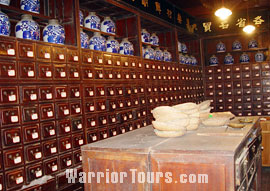Originated from the primitive society, the traditional Chinese medicine, which is totally different from the modern physic, mainly uses the various kinds of plants, animals and minerals. As a gem of China cultural treasures, traditional Chinese medicine is an important part of natural medicine and uses various plants, animals and minerals.
 History
History

ddd
|
In the third century AD, Doctor Zhang Zhongjing of the Eastern Han Dynasty wrote Treatise on febrile Diseases based on the medical classics of his predecessors. This book established the basic rules of diagnosis and treatment based on an overall analysis of the illness and the patient's condition and prepared the ground for the development of clinical medicine.
Scholar Huang Fumi of the Western Jin Dynasty composed the A-B Classic of Acupuncture and Moxibustion. This book consists of 12 volumes with 128 chapters, including 349 acupoints. As the earliest extant work dealing exclusively with acupuncture and moxibustion in China, it is one of the most influential works in the history of acupuncture and moxibustion on the earth.
In 610 AD, the Thesis on the Origins and Symptoms of Various Diseases was compiled by Chao Yuanfang (a physician to the Emperor of the Sui Dynasty), which is the earliest extant book especially for the origins and symptoms of various diseases.
Since the Sui & Tang Dynasties, doctors and medical works have been too many to enumerate. For example, Sun Simiao and his Thousand Jin Gold Prescription and Li Shizhen and his Compendium of Materia Medica.
Along with the spreading of western medicine, traditional Chinese medicine has recently begun its modernization, combining with the western medicine and modern science and technology.
 Nomenclature
Nomenclature
Traditional Chinese medicine is a large family with a large variety, and their names are also complicated. Generally speaking, most of the names were given according to their habitats, functions, features, smells and so on.
 Treatment
Treatment
Various treatments are adopted in traditional Chinese medicine, including medication, acupuncture, massage therapy, food therapy and so on.
![]() Medication: adjusting the qi and blood by taking medicines;
Medication: adjusting the qi and blood by taking medicines;
![]() Acupuncture: draining the channels and collaterals by the jab of a needle or moxibustion;
Acupuncture: draining the channels and collaterals by the jab of a needle or moxibustion;
![]() Massage therapy: curing illnesses by assisting patients doing some body movements to exercise the bones and muscles and drain the channels and collaterals;
Massage therapy: curing illnesses by assisting patients doing some body movements to exercise the bones and muscles and drain the channels and collaterals;
![]() Food therapy: preventing or curing illnesses by food with pharmacological effects or food mixed with medicines.
Food therapy: preventing or curing illnesses by food with pharmacological effects or food mixed with medicines.
 Taboos
Taboos
The taboos of traditional Chinese medicine include medicine using and dietetic restraint. For instance, if the efficacy of the different medicines opposes mutually, then they can't be used together; it isn't proper to eat shallot, garlic, pepper, mutton, dog or other hot food when you are taking medicines for clearing inner heat; some medicines have their own necessary food restraints e.g. pork is forbidden when you are taking liquorice, ebony or coptis. However, dietetic restraint should not go to the extreme especially for those sufferers of chronic diseases, because if they do not eat a large variety of food for a long time, their body can't absorb the nutrients deemed to be necessary for people in normal health, thus, the resistance of the human body will be weakened.

 How to extract herbal medicine
How to extract herbal medicine
It is best to use a casserole, a pottery pot or an enamel pot to extract the medicines, so that they can be heated evenly, thus, the efficacy of the medicines won't be reduced because of chemical change in the healing components. A dose is made up of many kinds of medicines, whose functions are different, so it is important to put the medicine into the extracting container according to the doctor's instructions. Before extracting the medicine, it is usual to immerse the ingredients in water for about half an hour; thus, their healing components can be extracted easily and fully. After boiling them with a big flame, use a smaller flame to extract the medicine for a further 20 to 30 minutes. Besides, medicine of different textures should be extracted accordingly for different periods of time. For example, 40 to 60 minutes for restorative medicines, and 5 to 10 minutes less for heat-clearing and diaphoretic medicines.
 How to take the medicine
How to take the medicine
Generally speaking, stomach medicine and tonic should be taken before meals, and irritative and pungent medicines should be eaten after meals. Usually, you should take the medicine twice a day at any time in the morning and in the evening, or you can also take it according to the characters of the medicines and your conditions, but it is best to take it when it is still warm in order to make it take effect soon.

